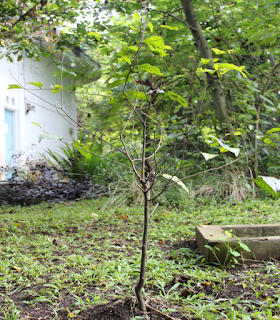Inocarpus fagiferus (Parkinson) Fosberg
Inocarpus fagiferus Tree
(Hidayat & Abdurrahman, 2017)
Inocarpus fagiferus Leaves
(Hidayat & Abdurrahman, 2017)
Inocarpus fagiferus Inflorences
(Hidayat & Abdurrahman, 2017)
Regnum : Plantae –
Plants
Subregnum : Tracheobionta –
Vascular plants
Divisio :
Magnoliophyta –
Flowering plants
Subclassis :
Rosidae
Classis :
Magnoliopsida –
Dicotyledons
Ordo :
Fabales
Familia :
Fabaceae –
Pea family
Genus : Inocarpus
Species : Inocarpus fagiferus
(Parkinson)
Fosberg
Description
Inocarpus fagifer is an evergreen tree with a dense canopy, usually growing up to 20 metres tall, though it can reach heights of 30 metres or more. The distinctive bole is short, thick, irregular, and very fluted, it can range in diameter from 7 - 90cm, with 30cm being fairly typicalThe tree has a shallow taproot and well formed network of lateral roots that are most prevalent in the topsoil layer (Useful Trpoical Plants, 2014). At the base of the trunk are 3 - 4 thin buttresses that extend up the trunk up to a height of about 1 metre and reach laterally, snake-like, for a long distance. Sometimes lateral roots extending from the buttresses are exposed on the soil surface (not buried in the soil); this could well be due to soil erosion. A plant of hot, humid, tropical lowlands at elevations below 500 metres. It is found in areas where the mean annual rainfall ranges from 1,500 - 4,300mm and there is only a small or no dry season. The mean annual temperature is around 27°c, with the hottest month ranging from 29.4 - 34.5°c and the coolest month 20 - 23°C (Useful Trpoical Plants, 2014). Plants are fairly shade tolerant, although heavy shade can reduce yields of seeds.The plant succeeds in a wide range of soils that include highly calcareous and saline soils and poorly drained seasonal to permanently waterlogged valleys, swamps, and marshes. It occurs in soils with medium to very low fertility rating. It can grow in mildly acidic to very alkaline coastal soils with a pH up to 14. It has medium to high tolerance of steady and strong winds and is windfirm due to a strong lateral root system including buttresses. The plant has a moderate to fast rate of growth, with annual increases in height when young of up to 2 metres per year.
This species is more or less a staple food for the inhabitants of some South Sea Islands, where it can grow abundantly. It is cultivated in some areas for its edible seed and is also sold (often as a cooked product) in local markets An attractive evergreen tree, it has potential for use in urban centers for beautification while also providing shade and shelter (Useful Trpoical Plants, 2014).
Leave are alternate, oblong, leathery, riggid and weak, young leave pink colored and green while get mature. They are 160–390 mm long and 70–130 mm wide. The petiole is 5 mm long. The apex is pointed and the base lobed, with an entire margin. The veins are opposite and yellow.
The fragrant flowers cluster along a short rachis at the ends of the branches and twigs. About 10 mm long, they have five white to cream or pale yellow petals. Trees begin flowering at 3–5 years old, with the flowering season usually taking place in November–December, and fruiting in the following January–February, though this varies through the tree’s range and from year to year (Achetron, 2018).
The tree starts bearing fruit at about eight years old. The fruits are slightly flattened, irregularly ovoid, rounded or oblong, and flanged at one end. Produced singly or in clusters, they weigh 50–110 g and are 46–130 mm long, 34–120 mm wide, and 40 mm thick. The smooth skin covers a fibrous shell which holds the kernel. As the fruits ripen their colour changes from green to yellow or orange-brown. The mature fruits are usually indehiscent (Achetron, 2018).
The seed is white and kidney-shaped and is contained within the thin brown, fibrous shell. It is relatively large, weighing 5–50 g, 20–70 mm long by 16–40 mm wide. The seed is toxic when raw but edible when cooked. It is perishable, with a short shelf life. The fleshy mesocarp, or pulp, of the fruit is eaten by cockatoos and flying foxes which act as seed dispersal agents (Achetron, 2018).
The tahiti chestnut is often used in traditional medicine, where it has a range of applications
The bark is used to treat sickness relapses. An infusion of the bark is used to treat burns; diarrhoea and teething problems in infants. A decoction of the bark is used in treating scabies. Extracts from heated bark scrapings are used in a treatment for pneumonia. The dried inner bark mixed with coconut oil is applied to bone fractures. The root is used to treat stomach-ache. Liquid from the stems is used to treat pain in the bones. Weakness after childbirth and fish poisoning are treated with the fluid from the leaves. The juice squeezed from fresh leaves is mixed with water and drunk daily in order to bring down a high malarial fever. The plant is also said to stop internal bleeding (Useful Trpoical Plants, 2014).
Location : Zone 3, UPI Botanical Garden
References
www.tropical.theferns.info
Please cite this article as:
Azis, A. M. (2019). UPI Seed Plants:Inocarpus fagiferus (Parkinson) Fosberg. Online at
https://upiseedplants-one-aldi.blogspot.com/. Accessed (Date)
Please cite this article as:
Azis, A. M. (2019). UPI Seed Plants:Inocarpus fagiferus (Parkinson) Fosberg. Online at
https://upiseedplants-one-aldi.blogspot.com/. Accessed (Date)







Comments
Post a Comment